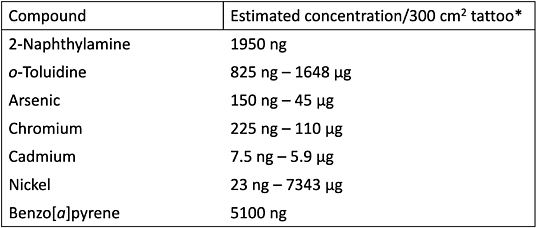
2024
What’s new, Guest commentary
On the Brink of Ink: The impact of tattoos and their safety
Tattoos have been a cornerstone in human expression for thousands of years. From an ancient iceman whose remains were found with tattoos across his body, to modern day tattoo conventions, this art form has transcended its ancient roots and is now a common form of expression.
Tattoos can represent a myriad of cultural phenomena. From indigenous cultural practices, to artistic and personal expression, to the reclamation of bodily autonomy, tattoos are ever-present and deeply rooted in our collective history. While their impact and importance cannot be overstated, a problematic concern exists. What do we really know about compounds in tattoo inks? Tattoo inks may contain a variety of toxic chemicals, including chemicals classified as carcinogenic or probably carcinogenic to humans.
A personal exploration in the world of tattoos
Deeply personal topics such as tattoos cannot be wholly explained though an objective scientific lens. Sensitivity must be exercised to invite curiosity and intrigue, not alienation. Navigating conversations around carcinogenic and potentially toxic compounds in tattoos inks can be difficult; it was definitely difficult for me.
My journey with tattoos is one of joy, expression, and excitement. I vividly remember the day I got my first tattoo. The experience was almost Herculean in nature; before, during, and after the tattoo session, I felt invincible. My first tattoo served as a symbol of resilience, proof that if I could successfully sit through a painful tattoo session, I could persevere through anything.
As I sit with curiosity and reflect on all of my now eight tattoos, I feel reassured knowing that I do not regret getting any of them. They’re special, they're unique, they’re me. They represent the reclamation of life and power.
Honoring the importance that tattoos have for individuals — and providing a space that evokes interest, not judgment or discouragement — has to be the foundation of the conversation.
Trust versus discernment: What does the literature say?
After setting intention, the core of the issue can be addressed — are the compounds found in tattoo inks harmful?
Simply put, tattoo inks are composed of pigments, binding agents, preservatives, and solvents; a deeper dive reveals a more insidious composition. These ingredients can include polycyclic aromatic hydrocarbons (PAHs), heavy metals, primary aromatic amines (PAAs), and dyes. These compounds can all pose hazards to human health; some of them are carcinogens, as shown in the table. In addition, heavy metals such as cadmium, lead, mercury, antimony, beryllium, and arsenic can lead to a number of chronic illnesses and other adverse health outcomes.
Carcinogens found in tattoo inks

*Carcinogenicity evaluated by the International Agency for Research on Cancer (IARC). Source: Foerster M, Schreiver I, Luch A, Schüz J. Tattoo inks and cancer, Cancer Epidemiology, Volume 65, 2020, 101655.
One case-control study in New Hampshire examined the association between tattoos and basal cell carcinoma. The authors found a possible increased risk of early basal cell carcinoma at the site of cosmetic tattoos compared to a non-tattooed body part. Comprehensive epidemiological studies have not yet been conducted on potential carcinogenicity of tattoo inks. This absence of research actively contributes to our collective lack of knowledge around this topic.
For many compounds used in tattoo inks, no ‘safe’ level of exposure has been defined. There is a lack of regulation of these compounds in general, and of their use in tattoo inks. It’s important to remember that, just because we haven’t done the studies to know if inks are hazardous, doesn’t mean they’re safe. In short: absence of evidence (about a hazard) is not evidence of absence (of the hazard).
Oversight and regulations: Comparing the US and the EU
The only draft guidance that the Food and Drug Administration (FDA) has published for tattoo inks is regarding unsanitary conditions and microbial contamination. While this draft guidance does have merit, the FDA is not fully exercising its legal authority to regulate tattoo inks, specifically regarding carcinogens and other potentially toxic compounds found in the inks.
Conversely, the European Union (EU) has made significant strides. In 2020, the EU implemented widespread regulation aimed at reducing exposure to hazardous chemicals in tattoo inks. The regulation now covers approximately 4,000 toxic substances that can cause serious adverse health outcomes.
As Dr. David Kriebel discussed in the recent CHE webinar, Tattoo Inks, Cancer and Other Chronic Diseases: Gaps in research and regulation, many regulations in the EU follow the precautionary principle, while the U.S. follows a ‘reactionary principle’. To bridge this gap, the US can follow the EU’s lead in protecting the public from needless toxic chemicals in tattoo inks.
What now?
As consumers, we deserve to feel confident and secure when purchasing/utilizing cosmetic products, and this consideration should apply to tattoo inks as well. The public deserves to feel safe knowing that their tattoo inks aren’t contributing to cancer and other adverse health outcomes.
With that being said, as I mentioned earlier, discouragement is not the answer — education and awareness are.
Investing in more robust epidemiological studies examining the relationship between harmful compounds and carcinogens in tattoo inks is key to ensuring public safety. We don't know what we don't know, but we all deserve to know more.
To learn more, see our conversation with Dr. Kreibel: Tattoo Inks, Cancer and Other Chronic Diseases: Gaps in research and regulation.


 By Andre Green, MSW
By Andre Green, MSW